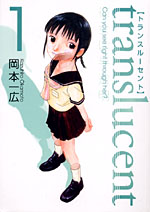 By Kazuhiro Okamoto
By Kazuhiro Okamoto
192 pages, black and white
Published by Dark Horse
One thing I’ve noticed about a lot of manga is that the series can often begin with a chapter that feels like (to use a television term) a “pilot episode”—a single story that will be used to convince the publisher that you have what it takes to go to series. Often these comic book “pilots” are stand-alone stories, so even if it doesn’t get picked up for a series you can run the one-off story and call it a day. What surprised me about Dark Horse’s Translucent, then, is that after reading the first chapter I’d mentally written off the rest of the book as an idea that had already run its course, with nothing more to say. I was quite happy, though, to discover that I was absolutely wrong.
Shizuka has what’s known as “translucent syndrome”—a rare new affliction that causes parts or all of your body to gradually become see-through. As Shizuka struggles to come to terms with the idea that she might become completely invisible, Mamoru is determined to let the shy Shizuka know that she isn’t allowed to fade into the background, no matter how tempting that may be.
 Kazuhiro Okamoto’s basic idea in Translucent, where shyness or a desire to step out of the spotlight turns into a physical manifestation, is a simple but clever one. Maybe it was because of its simplicity, though, that I thought it didn’t need to continue past its first installment. To Okamoto’s credit, though, the series doesn’t mine the same story over and over again. Instead, Okamoto takes the idea to its logical extension. So while shy Shizuka is still a main character, she’s not the only one afflicted. Why would a superstar student sudden start turning translucent? Would there be people who would use their translucent nature to their advantage? And was there something that caused Shizuka to become the shy, retiring person that she is? Okamoto keeps enough variation going in Translucent that it kept my attention all the way to the end of the book.
Kazuhiro Okamoto’s basic idea in Translucent, where shyness or a desire to step out of the spotlight turns into a physical manifestation, is a simple but clever one. Maybe it was because of its simplicity, though, that I thought it didn’t need to continue past its first installment. To Okamoto’s credit, though, the series doesn’t mine the same story over and over again. Instead, Okamoto takes the idea to its logical extension. So while shy Shizuka is still a main character, she’s not the only one afflicted. Why would a superstar student sudden start turning translucent? Would there be people who would use their translucent nature to their advantage? And was there something that caused Shizuka to become the shy, retiring person that she is? Okamoto keeps enough variation going in Translucent that it kept my attention all the way to the end of the book.
Okamoto’s art in Translucent is simple but pleasant. It reminds me a bit of Mohiro Kitoh’s art for the (sadly cancelled in English) series Shadow Star with its delicate plaits of hair and stripped down, innocent faces on its characters. Okamoto does his best work with drawing the partially- or completely-translucent characters in the series, letting you see other characters and backgrounds through their semi-opaque (or entirely absent) bodies, in such a way that really brings home their condition. On the other hand, it sometimes feels like backgrounds only exist to be seen through Shizuka and company; more panels than not seem to have nothing present but the character in the forefront. It’s a nice, if somewhat unremarkable art style.
When I’d finished reading the first volume of Translucent I immediately went to look at the AnimeOnDVD.com manga resources page to see how many volumes the series ran in Japan. I was pleased, then, to discover that while three volumes were published to date, more are en route. The first volume was a thoroughly enjoyable book, and if Okamoto can keep up the variety of story and forward progression of the characters, well, I’ll be sticking around so long as it’s published in English.
Purchase Links: Amazon.com
